The
Home Page Selection
If
you require further information on any
print featured here, please contact
us.
When
a print has been sold it will be marked
as Sold.
A
growing archive of selections
from previous Home pages is featured in
the
Home
Page Selection Archive |
|
See
also :
Click
on a thumbnail (left)
to link directly with the entry for that
print, or scroll down to view all the selected
prints from the current Home
Page.
Images
are not to relative scale (see stated dimensions) and also at only modest resolution.
If you wish to view extracts of an image at higher resolution, please Contact us.
|
|
|
|
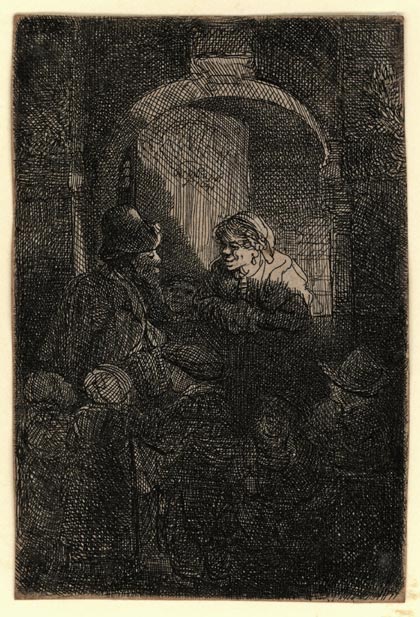
| |
REMBRANDT HARMENSZ. VAN RIJN
Leiden 1606 – 1669 Amsterdam
This plate used to be known as The School Master, or alternatively A Woman at a Doorhatch, but in recent years has been recognized to be a hurdy-gurdy player with a following of children.
A Hurdy-Gurdy Player
followed by children at the door of a house
New Hollstein 191 i/iv; Bartsch 128
94 x 63 mm
Original etching, 1641.
The plate signed and dated on the open door.
First state, before any rework, a slightly later impression.
Trimmed to or fractionally into the platemark.
Good condition.
One rust spot on the woman’s cap.
Sold
Return to top ^ |
|
|
|
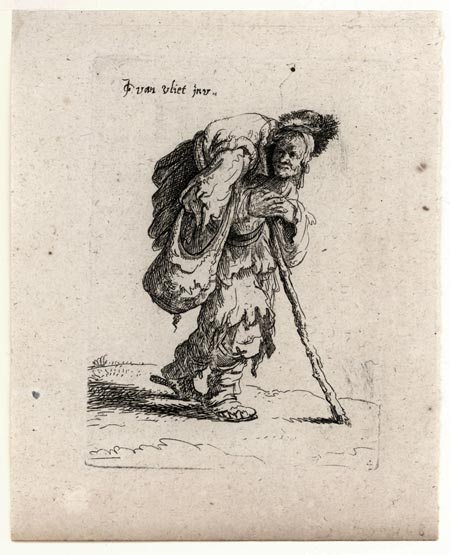 |
|
JOHANNES JORISZ. VAN VLIET A.R.C.A.
Delft c1605-10 – c1668
Van Vliet was a pupil of Rembrandt in Leyden during the period from about 1628 till late 1631 when Rembrandt moved to Amsterdam.
In van Vliet’s series of ten beggars, By T Geeue Bestaet ons Leeue, first published in 1632, the influence of Rembrandt is strong. In this period Rembrandt had also etched quite a number of small plates of beggars, one even was a self-portrait.
Despite emblem books castigating beggars and other ‘undesirables’ in moralising proverbs, images of beggars and itinerant tradesmen were popular. The vogue had been initiated by Jacques Callot in 1622 with his series of beggars in undefined backgrounds, Les Gueux.
Van Vliet’s series of etchings of beggars was popular, as it was both re-printed and copied.
Humpbacked Beggar
Hollstein 74 iii/iv
92 x 66 mm
Original etching, c1632, for the series By T Geeue Bestaet ons Leeue.
The plate signed.
With the plate number 4 (added in the 3rd state and removed in the 4th state).
On laid paper with margins.
Sold
Return to top ^ |
|
|
|
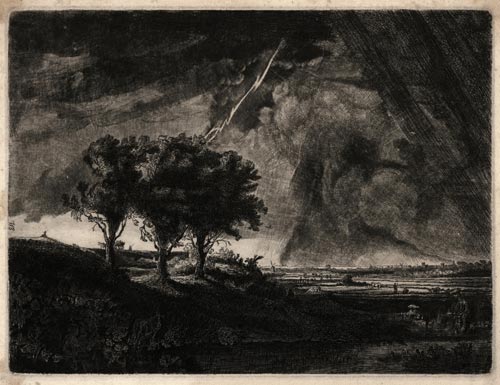 |
|
Captain WILLIAM BAILLIE
Kilbride, County Carlow, Ireland 1723 – 1810 London
Baillie came to London after being educated in Dublin. About 1744 he joined the army, first serving with the Somerset Light Infantry. When he retired from the army in 1761 he had reached the rank of captain. From 1773 to 1795 he would be Commissioner of Stamps, as well as continuing to be involved in printmaking and art dealing.
Baillie had begun drawing in 1750 at the age of twenty-seven and made his first etchings in 1753. He received some instruction from his friend Nathaniel Hone, the portrait and miniature painter, a fellow Irishman and Rembrandt enthusiast.
Baillie exhibited thirty-one etchings at the Society of Artists, of which he was an honorary member, between 1762 and 1776.
Baillie is best known for his acquisition of Rembrandt’s etching plate for the Hundred Guilder Print (Christ Preaching) in 1775, which he reworked and published in an international edition to subscribers, and then cut the plate into four pieces and printed them separately. He owned two other Rembrandt copper plates, The Goldweigher and Cornelis Claesz Anslo.
The Three Trees
New Hollstein 214 Rembrandt copy A iii/vi
210 x 280 mm
Etching, 1753, a reverse copy after Rembrandt .
Third state of six, with Baillie’s monogram initials at the centre left edge, and a single bolt of lightning.
On laid paper, corner mounted in the narrow margins to a backing sheet, with related stains in the margins at the left corners.
Sold
The Three Trees was Baillie’s first etching made after Rembrandt.
The landscape, with the distant view of Amsterdam and the various obscured foreground figures, as well as the sky at the right, are accurate copies, in reverse, of the Rembrandt etching but through successive states Baillie made the sky at the left increasingly dramatic, adding dark clouds behind the three trees (in Rembrandt the trees are silhouetted against a clear light area of sky) as well as a growing number of lightning bolts.
The Landscape with the three trees (B.212) only acquired this title in 1752 (the year before it was etched by Baillie) in Gersaint’s catalogue raisonné of Rembrandt’s etchings, the first such compilation.
Rembrandt’s most ambitious etched landscape, it dated from 1643 and is amongst the first ever etchings to include the motif of visible streaks of falling rain. Hidden in the foreground is a pair of lovers in a bower, with nearby a donkey by the side of the water on one side, and a fisherman and his wife on the other. On the skyline behind the trees are a horse and laden cart and a couple of figures, one looking very like an artist sitting sketching.
Return
to top ^ |
|
|
|
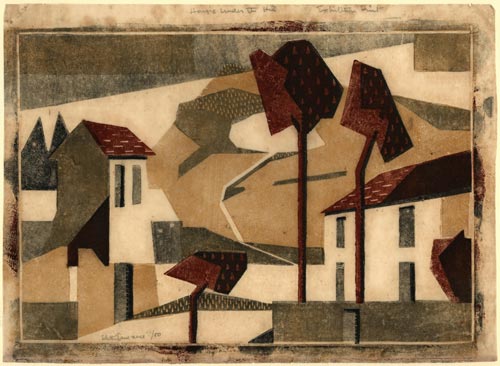 |
|
EDITH LAWRENCE
Walton on Thames 1890 – 1973 Salisbury
Lawrence was a prize-winning painting student at the Slade 1910-1914. She first exhibited in 1916, at the Royal Academy and with the New English Art Club. While working in Cornwall in 1920 she met Claude Flight, who from 1925 became her lifelong partner and associate. He presumably introduced her to linocut, which he had first broached in 1919, and would teach at the Grosvenor School 1926-30, organising annual exhibitions of colour linocuts from 1929-39. In 1927 they formed an interior design business using linocut in textile and graphic design, working together designing and cutting the blocks.
Edith Lawrence exhibited her independent linocuts in Flight’s exhibitions from 1929 until 1937.
Houses under the Hill
228 x 332 mm (image); 267 x 364 mm (sheet)
Original colour linocut, c1929-30.
Signed in pencil and numbered 1/50 within the image.
Annotated in pencil in the blank margin at the top of the sheet, Houses under the Hill and Exhibition Print.
Printed from four blocks in ochre, blue, blue-grey and brown-red, on tissue-thin japan.
£7500
Return
to top ^
|
|
|
|

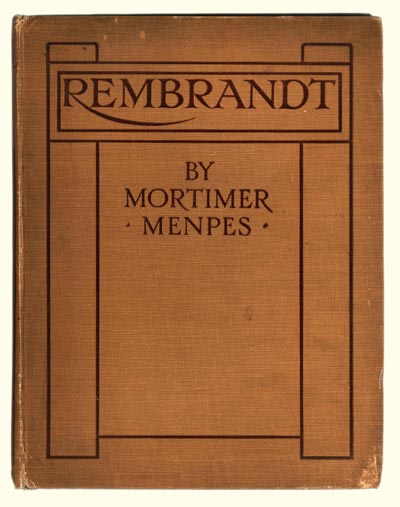
|
|
MORTIMER MENPES R.E.
Port Adelaide, Australia 1855 – 1938 Pangbourne
In Australia Menpes attended the Adelaide School of Design 1868-74.
He settled in London in 1875 and in 1878 enrolled in the National Art Training School at South Kensington (later called the R.C.A.) where he studied etching with Legros and won the Poynter Prize in 1879. 1880 proved a remarkably successful breakthrough year for him; he exhibited etchings at the R.A., Dowdeswells and the Fine Art Society.
Menpes developed parallel interests in colour printing.
He first exhibited etchings printed with coloured inks at Dowdeswells in 1897, and was a pioneer of original colour etching in Britain, pre-empting Theodore Roussel by a year or two. Menpes was equally involved in reproductive colour plate printing for art books.
Menpes made his first etching after Rembrandt in 1889, a Portrait of an old Man, which is only known from its catalogue listing at the Grosvenor Gallery where it was exhibited, but presumably it was copied from a Rembrandt oil, rather than an etching, as Menpes’ two other later etched Rembrandt copies are both from paintings.
Breton Interior, Pont Aven
Morgan 589, Menpes 376
200 x 163 mm
Etching, 1915-16.
Signed in pencil.
Printed in colours on cream wove.
(Only colour impressions are known).
£450
The colour etching offered here is directly related, in reverse, to the watercolour reproduced in Menpes’ book Brittany, 1905. But (despite lacking the Holy personnel) it has parallels too to Rembrandt’s painting of the Holy Family with Angels, in the Hermitage, in its tenderness, its golden light on the cradle in a peaceful dark interior, and even the secondary source of light from the fire at the right. Menpes painted a copy of this Rembrandt for his series “The Great Masters” which was reproduced in his book Rembrandt by Mortimer Menpes, also published in 1905.
A reproduction of Rembrandt's original painting, as well as Menpes' copy, are reproduced on the left, and clicking the thumbnails will reveal enlargements of both.
This plate is from Menpes’ final period when he etched only as a pastime, and not for exhibition or publication, and often revisiting earlier subjects.
Menpes visited Brittany a number of times, in 1876-78; 1881-82; 1888-90 (when he got to know Gauguin, who painted his daughter Dorothy); 1895; and 1899, his final visit to Brittany. This last visit was described by his daughter Dorothy in Menpes’ 1905 book Brittany.
In middle age Menpes became increasingly interested in book production. He travelled the world painting and used his watercolours for a number of illustrated books, such as Brittany.
In relation to this he sought a means of good colour reproduction and worked to this end with Carl Henschel who pioneered a new three-colour printing method, the Henschel Colourtype process, which involving colour-filtered photographs to make printing blocks. In 1901 the artist set up the Menpes Press to print the colour plates for his own books published by A & C Black.
In tandem with this there was the (uncompleted) project of the Menpes Series of Great Masters, painted copies by Menpes to be reproduced as both individual prints and in books. The first in this projected series was his book on Rembrandt.
Rembrandt by Mortimer Menpes
With an essay on the Life and Work by C Lewis Hind
Hardback quarto book, with sixteen colour illustrations reproducing Menpes’ painted copies of Rembrandt paintings. (“The illustrations in this volume have been engraved and printed at the Menpes Press.”)
Published 1905 by A & C Black.
Cover a little knocked.
Some foxing.
Sold
Return
to top ^ |
|
|
|
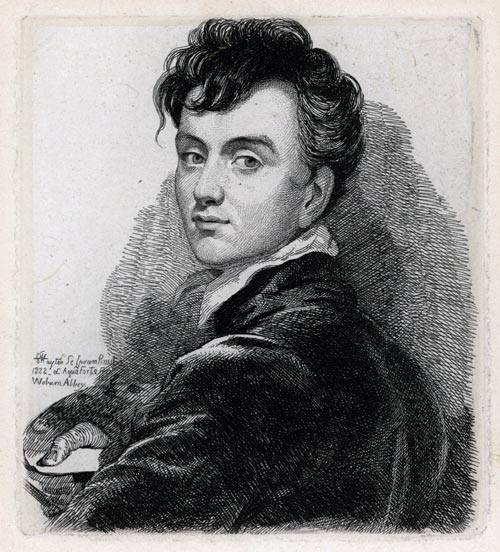 |
|
Sir GEORGE HAYTER
London 1792 – 1871 London
Hayter’s life had some interesting parallels with Rembrandt’s.
He too made quite a number of self-portraits, though mainly as oils and drawings; only three were etchings. He also (scandalously) lived openly with his mistress; though after his wife had left him, rather than died (and he did not seek a divorce).
A Romantic artist, Hayden also had a ‘romantic’ life. He was the son of Charles Hayter, a miniature painter and Professor of Perspective and Drawing to Princess Charlotte. Taught initially by his father, in 1808 he began to attend the Royal Academy Schools, under Fuseli, but ran away to sea as a Midshipman in the same year. His father arranged his release from the Royal Navy and Hayter returned to working in his father’s studio.
In 1809, aged only fifteen or sixteen, Hayter secretly married the family lodger, his senior by a dozen or so years. By 1815 he was appointed Painter of Miniatures and Portraits to Princess Charlotte. The following year his wife, with whom he had had three children, left him.
And that year too, his patron, the Duke of Bedford encouraged him to pursue his studies in Italy. There he became friendly with Canova, painted his portrait and probably learnt to sculpt with him. Canova probably proposed him as an honorary member of Rome’s Accademia di San Luca; where he became the Academy’s youngest ever member.
Back in London in 1818 he set up as a portrait and history painter and through the 1820’s had considerable success amongst the aristocracy.
Hayter had taken up etching in 1815, and entertained aristocratic households, in evenings spent with them, in etching plates spontaneously in front of them. In 1824, at Woburn, home of the Duke of Bedford, Hayter etched four plates, including this self-portrait, based in reverse on a painting he had done for the Duke in 1822.
This plate was used as the frontispiece when twelve other of his plates were first published in 1833; their only formal lifetime issue. (The Self-Portrait was not included in the James Rimmell album of 46 of Hayter’s etchings, published posthumously in 1874.)
Self-Portrait
Alexander 33
135 x 122 mm
Etching, 1824.
The plate signed and dated (inscribed precisely G Hayter Se Ipsum Pinxit 1822, et Aqua Forte Fecit 1824 Woburn Abbey).
Issued as the frontispiece to ‘Twelve Original Etchings by George Hayter ’, published by J Dickinson, Bond Street, 1833.
First and only edition.
On chine appliqué on wove.
A couple of fox marks in the margins of the support sheet.
£500
Return
to top ^
|
|
|
|
 |
|
CLAUGHTON PELLEW
Redruth, Cornwall 1890 – 1966 The Pightle, near Southrepps, Norfolk
Born William Pellew-Harvey, the son of a mining engineer and an artist mother, childhood family holidays were frequently spent in Norfolk, a county he grew to love.
Pellew studied at the Slade, 1907-1911, where he was particularly friendly with Paul Nash. After graduating, Pellew (he had dropped Harvey from his surname as a student) took lodgings in Mundesley-on-Sea in Norfolk in 1912. Except for some Continental travel, and detention and war work 1916-18 (he was a conscientious objector), Pellew and his wife, also a Slade student whom he married in 1919, spent the rest of their lives in Norfolk.
Pellew began to wood-engrave in 1923 and was active in the medium a decade and more.
The Plough
Stevens (Ashmolean) 42
92 x 126 mm
Original wood-engraving, 1928.
The block initialled.
Signed in pencil, dated (1929), entitled and numbered 12/25.
On japan.
Sold
Exhibited at the annual exhibition of the English Wood Engraving Society, 1928.
Return
to top ^
|
|
|
|
|
|
|
|